Strategies for Sustainable Groundwater Management in Asian Urban Areas
VerifiedAdded on 2020/05/11
|15
|2629
|114
AI Summary
The assignment provides a comprehensive analysis of sustainable groundwater management practices necessary to tackle the adverse effects of rapid urbanization and industrial activity in Asian cities. Groundwater, a crucial resource for drinking water, agriculture, and industry, is facing increasing challenges due to factors such as over-extraction, pollution, and climate change. This piece examines wastewater treatment inadequacies leading to pollution, heavy metal contamination risks from agricultural practices, and the broader implications of these environmental issues on human health and ecosystems. The analysis draws upon various studies that highlight the urgency for integrated water resources management strategies, incorporating adaptive planning, policy reforms, and technological advancements to ensure long-term groundwater sustainability.
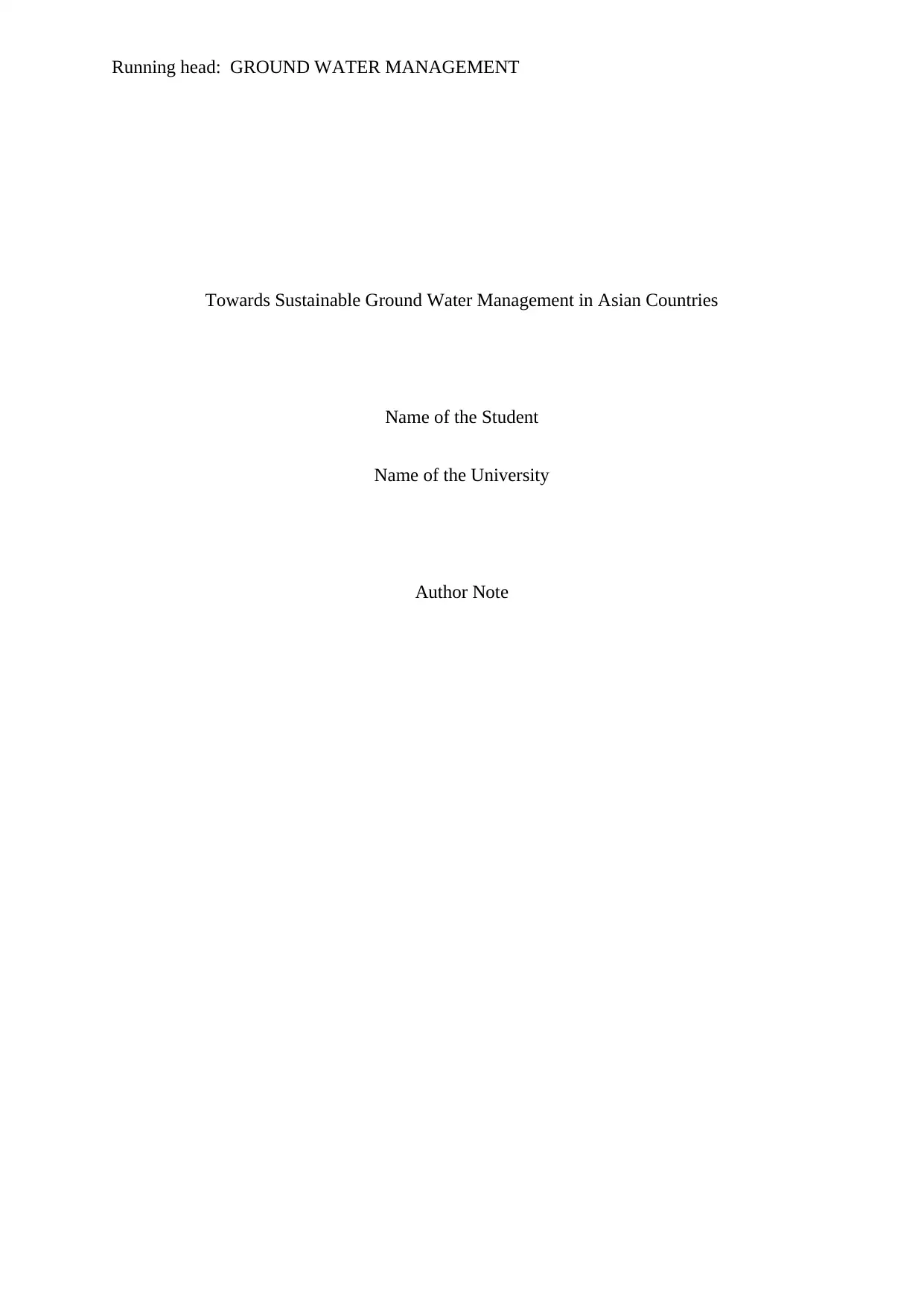
Running head: GROUND WATER MANAGEMENT
Towards Sustainable Ground Water Management in Asian Countries
Name of the Student
Name of the University
Author Note
Towards Sustainable Ground Water Management in Asian Countries
Name of the Student
Name of the University
Author Note
Paraphrase This Document
Need a fresh take? Get an instant paraphrase of this document with our AI Paraphraser
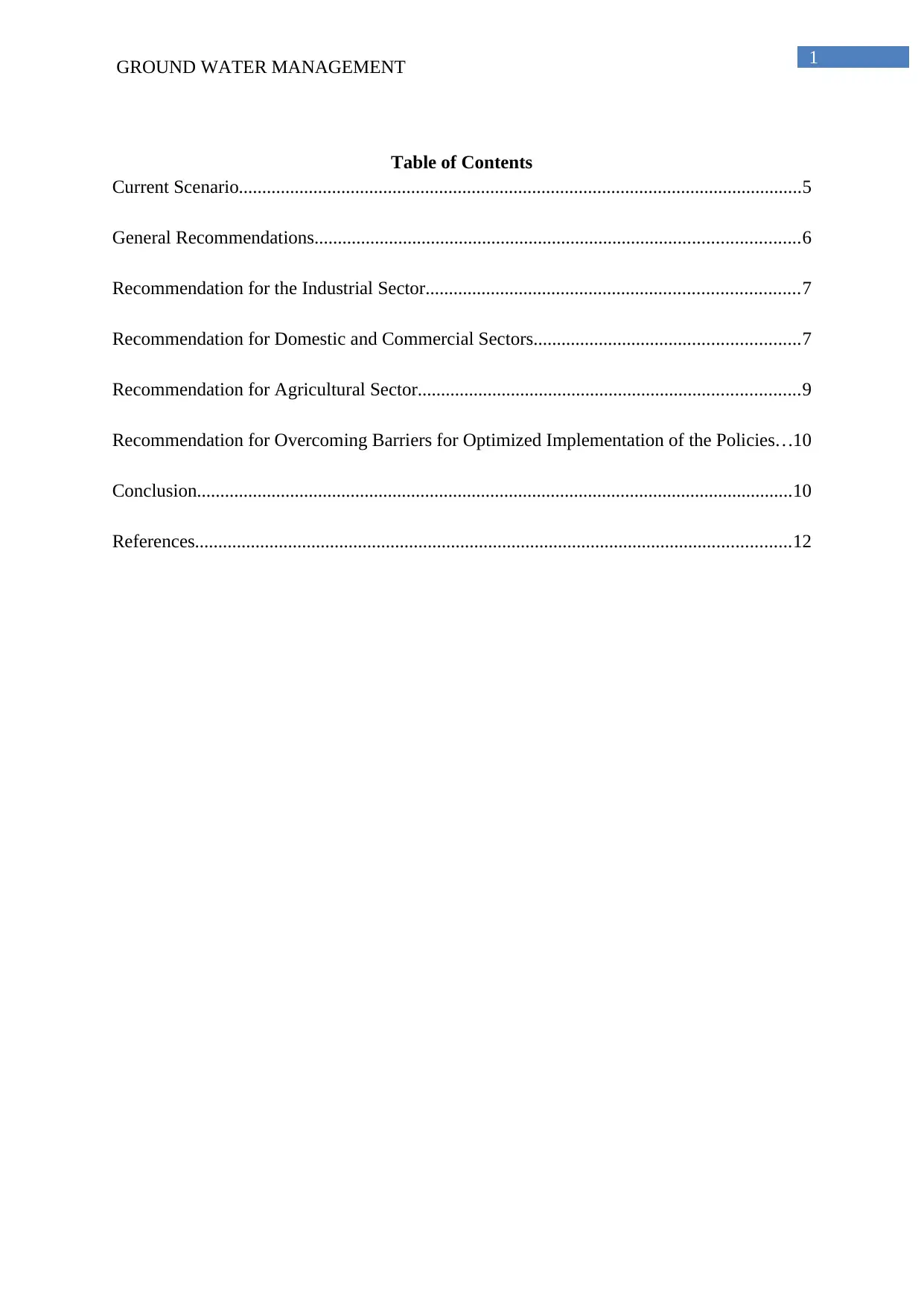
1
GROUND WATER MANAGEMENT
Table of Contents
Current Scenario.........................................................................................................................5
General Recommendations........................................................................................................6
Recommendation for the Industrial Sector................................................................................7
Recommendation for Domestic and Commercial Sectors.........................................................7
Recommendation for Agricultural Sector..................................................................................9
Recommendation for Overcoming Barriers for Optimized Implementation of the Policies...10
Conclusion................................................................................................................................10
References................................................................................................................................12
GROUND WATER MANAGEMENT
Table of Contents
Current Scenario.........................................................................................................................5
General Recommendations........................................................................................................6
Recommendation for the Industrial Sector................................................................................7
Recommendation for Domestic and Commercial Sectors.........................................................7
Recommendation for Agricultural Sector..................................................................................9
Recommendation for Overcoming Barriers for Optimized Implementation of the Policies...10
Conclusion................................................................................................................................10
References................................................................................................................................12
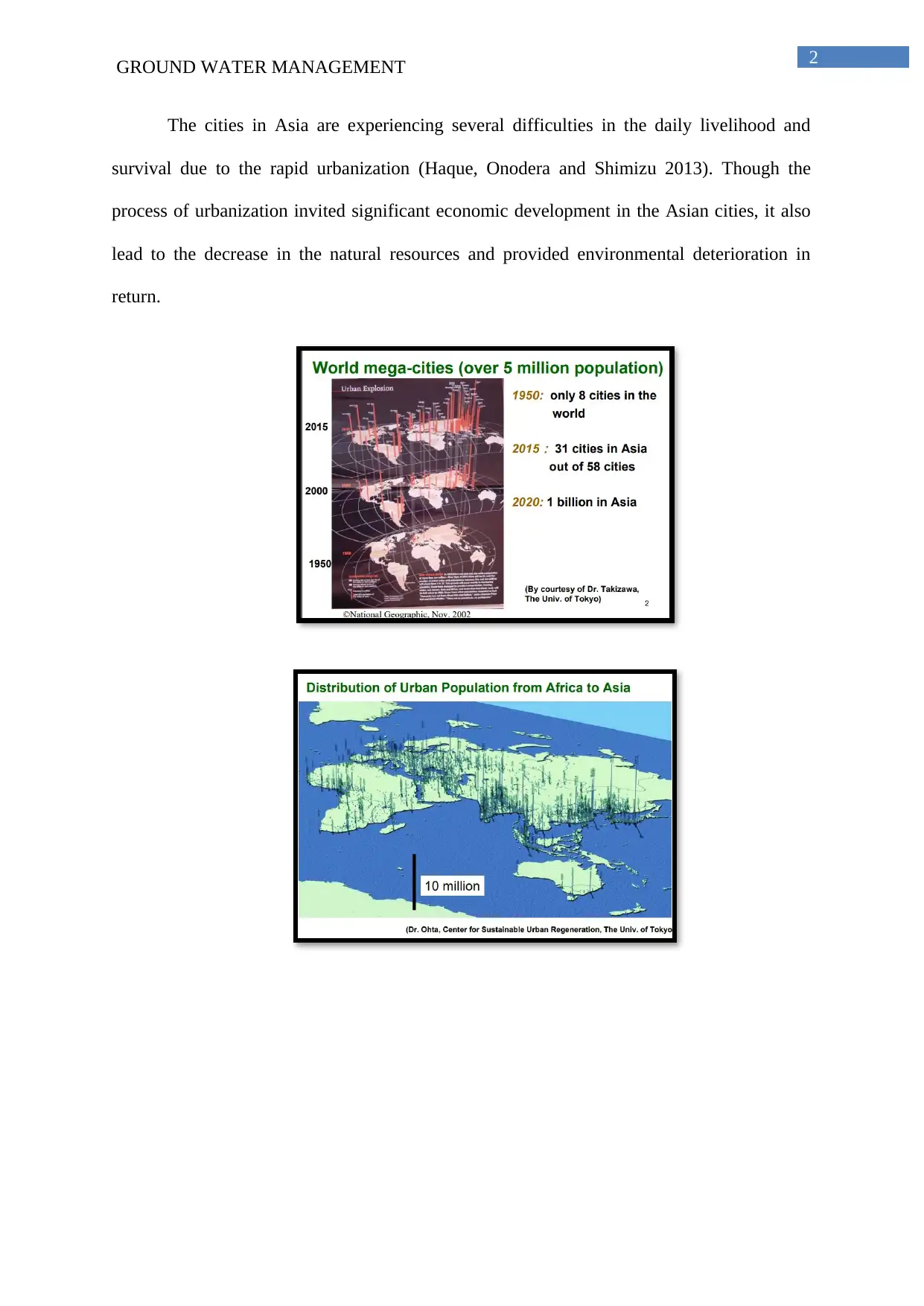
2
GROUND WATER MANAGEMENT
The cities in Asia are experiencing several difficulties in the daily livelihood and
survival due to the rapid urbanization (Haque, Onodera and Shimizu 2013). Though the
process of urbanization invited significant economic development in the Asian cities, it also
lead to the decrease in the natural resources and provided environmental deterioration in
return.
GROUND WATER MANAGEMENT
The cities in Asia are experiencing several difficulties in the daily livelihood and
survival due to the rapid urbanization (Haque, Onodera and Shimizu 2013). Though the
process of urbanization invited significant economic development in the Asian cities, it also
lead to the decrease in the natural resources and provided environmental deterioration in
return.
⊘ This is a preview!⊘
Do you want full access?
Subscribe today to unlock all pages.

Trusted by 1+ million students worldwide
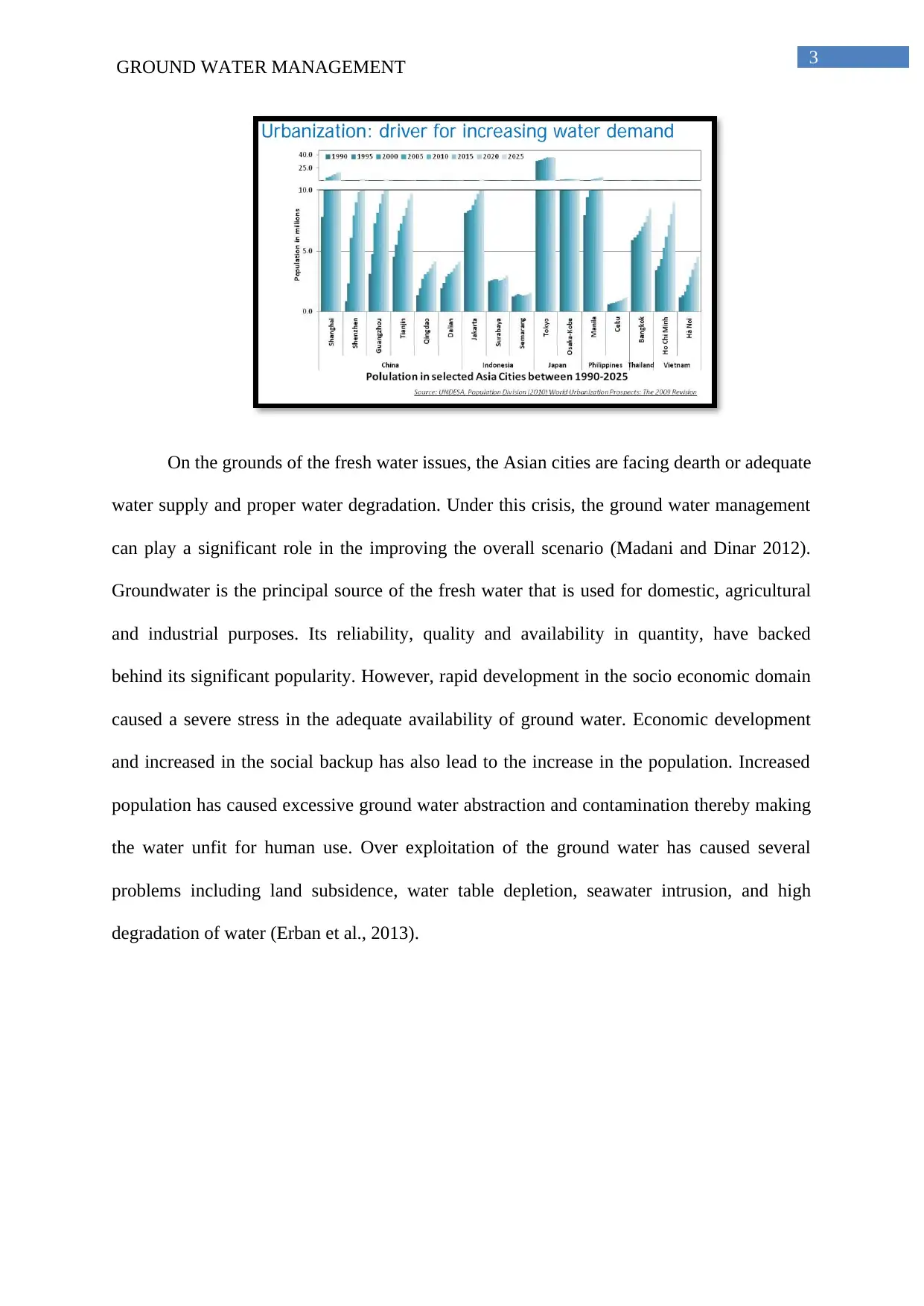
3
GROUND WATER MANAGEMENT
On the grounds of the fresh water issues, the Asian cities are facing dearth or adequate
water supply and proper water degradation. Under this crisis, the ground water management
can play a significant role in the improving the overall scenario (Madani and Dinar 2012).
Groundwater is the principal source of the fresh water that is used for domestic, agricultural
and industrial purposes. Its reliability, quality and availability in quantity, have backed
behind its significant popularity. However, rapid development in the socio economic domain
caused a severe stress in the adequate availability of ground water. Economic development
and increased in the social backup has also lead to the increase in the population. Increased
population has caused excessive ground water abstraction and contamination thereby making
the water unfit for human use. Over exploitation of the ground water has caused several
problems including land subsidence, water table depletion, seawater intrusion, and high
degradation of water (Erban et al., 2013).
GROUND WATER MANAGEMENT
On the grounds of the fresh water issues, the Asian cities are facing dearth or adequate
water supply and proper water degradation. Under this crisis, the ground water management
can play a significant role in the improving the overall scenario (Madani and Dinar 2012).
Groundwater is the principal source of the fresh water that is used for domestic, agricultural
and industrial purposes. Its reliability, quality and availability in quantity, have backed
behind its significant popularity. However, rapid development in the socio economic domain
caused a severe stress in the adequate availability of ground water. Economic development
and increased in the social backup has also lead to the increase in the population. Increased
population has caused excessive ground water abstraction and contamination thereby making
the water unfit for human use. Over exploitation of the ground water has caused several
problems including land subsidence, water table depletion, seawater intrusion, and high
degradation of water (Erban et al., 2013).
Paraphrase This Document
Need a fresh take? Get an instant paraphrase of this document with our AI Paraphraser
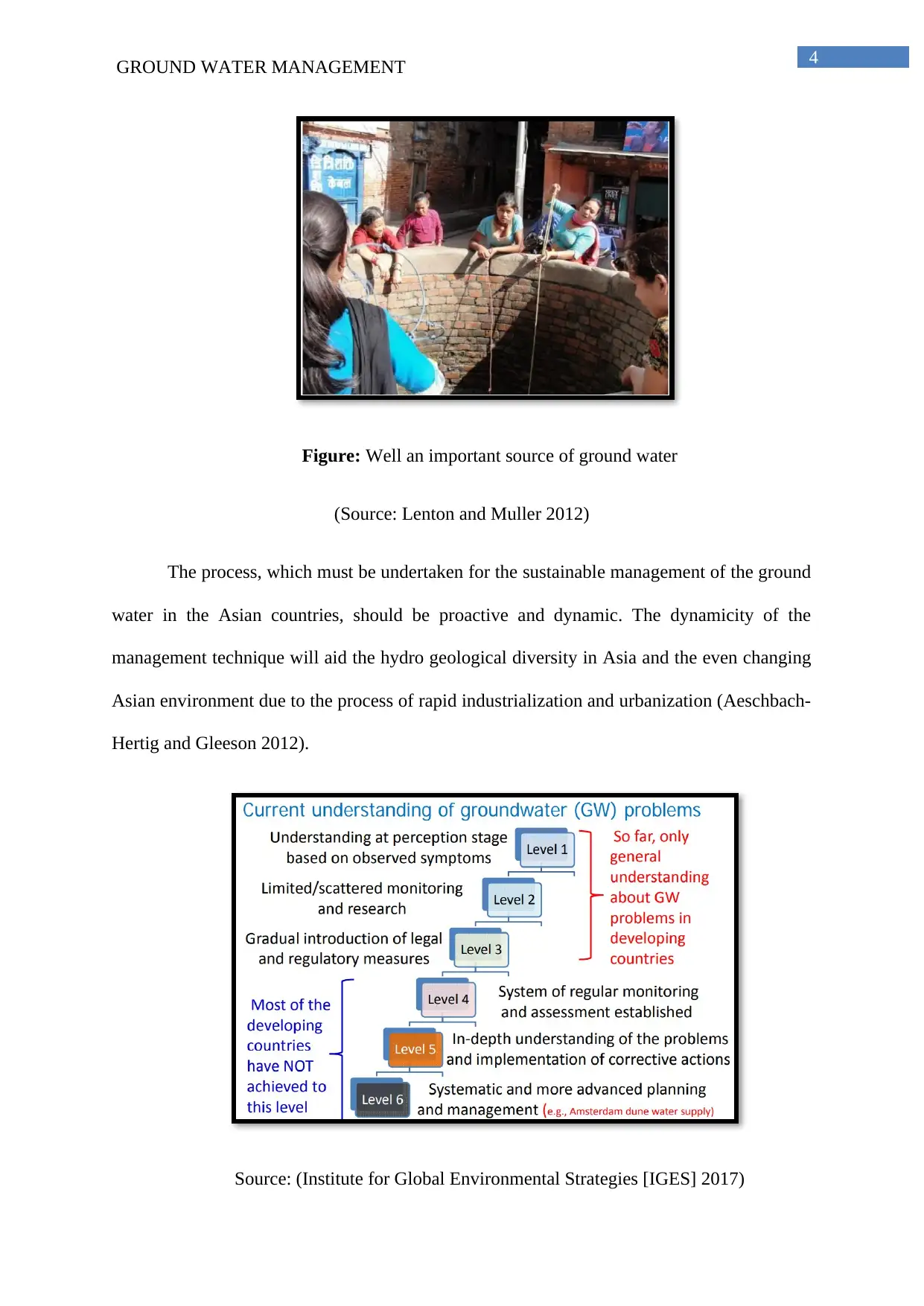
4
GROUND WATER MANAGEMENT
Figure: Well an important source of ground water
(Source: Lenton and Muller 2012)
The process, which must be undertaken for the sustainable management of the ground
water in the Asian countries, should be proactive and dynamic. The dynamicity of the
management technique will aid the hydro geological diversity in Asia and the even changing
Asian environment due to the process of rapid industrialization and urbanization (Aeschbach-
Hertig and Gleeson 2012).
Source: (Institute for Global Environmental Strategies [IGES] 2017)
GROUND WATER MANAGEMENT
Figure: Well an important source of ground water
(Source: Lenton and Muller 2012)
The process, which must be undertaken for the sustainable management of the ground
water in the Asian countries, should be proactive and dynamic. The dynamicity of the
management technique will aid the hydro geological diversity in Asia and the even changing
Asian environment due to the process of rapid industrialization and urbanization (Aeschbach-
Hertig and Gleeson 2012).
Source: (Institute for Global Environmental Strategies [IGES] 2017)
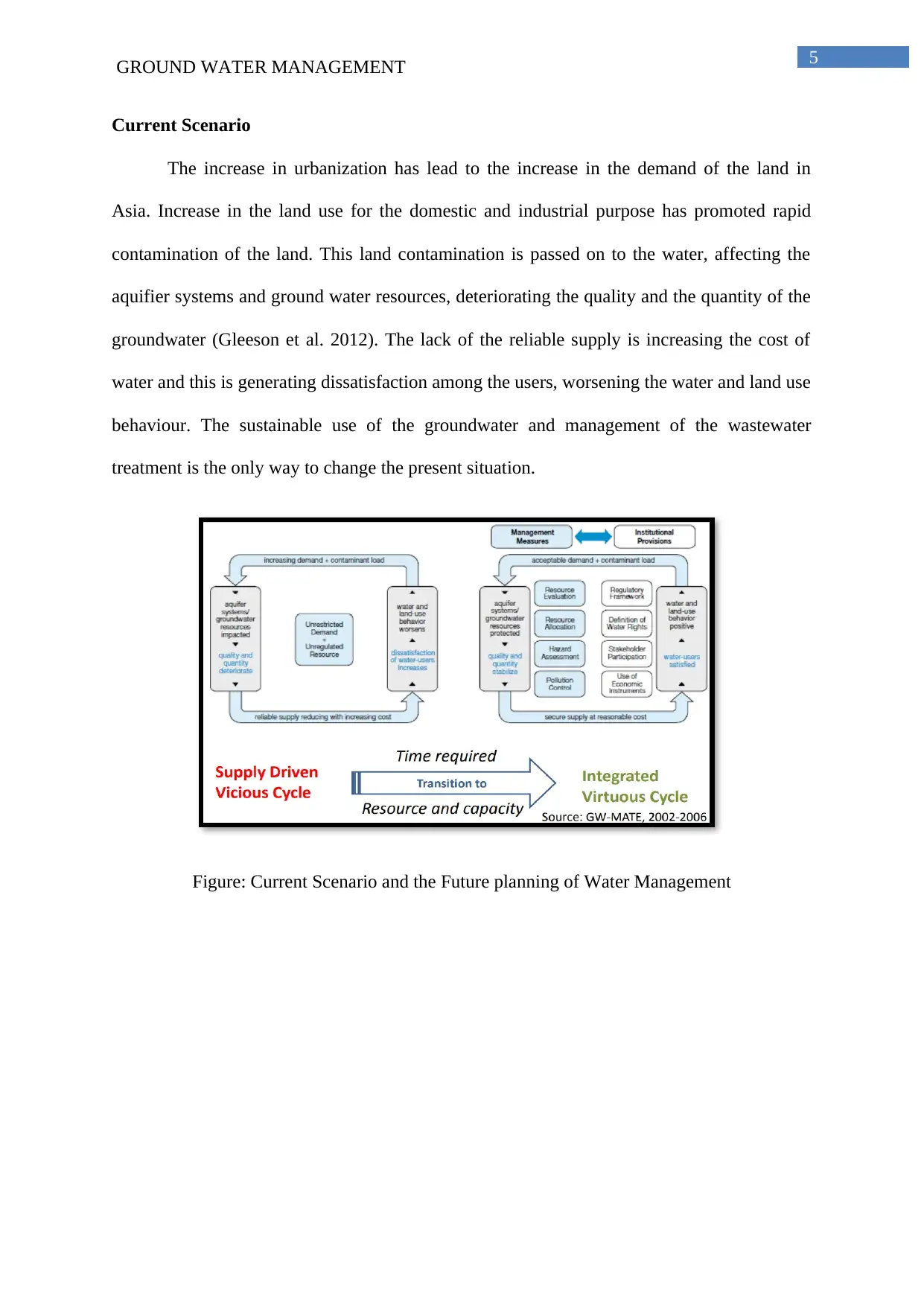
5
GROUND WATER MANAGEMENT
Current Scenario
The increase in urbanization has lead to the increase in the demand of the land in
Asia. Increase in the land use for the domestic and industrial purpose has promoted rapid
contamination of the land. This land contamination is passed on to the water, affecting the
aquifier systems and ground water resources, deteriorating the quality and the quantity of the
groundwater (Gleeson et al. 2012). The lack of the reliable supply is increasing the cost of
water and this is generating dissatisfaction among the users, worsening the water and land use
behaviour. The sustainable use of the groundwater and management of the wastewater
treatment is the only way to change the present situation.
Figure: Current Scenario and the Future planning of Water Management
GROUND WATER MANAGEMENT
Current Scenario
The increase in urbanization has lead to the increase in the demand of the land in
Asia. Increase in the land use for the domestic and industrial purpose has promoted rapid
contamination of the land. This land contamination is passed on to the water, affecting the
aquifier systems and ground water resources, deteriorating the quality and the quantity of the
groundwater (Gleeson et al. 2012). The lack of the reliable supply is increasing the cost of
water and this is generating dissatisfaction among the users, worsening the water and land use
behaviour. The sustainable use of the groundwater and management of the wastewater
treatment is the only way to change the present situation.
Figure: Current Scenario and the Future planning of Water Management
⊘ This is a preview!⊘
Do you want full access?
Subscribe today to unlock all pages.

Trusted by 1+ million students worldwide
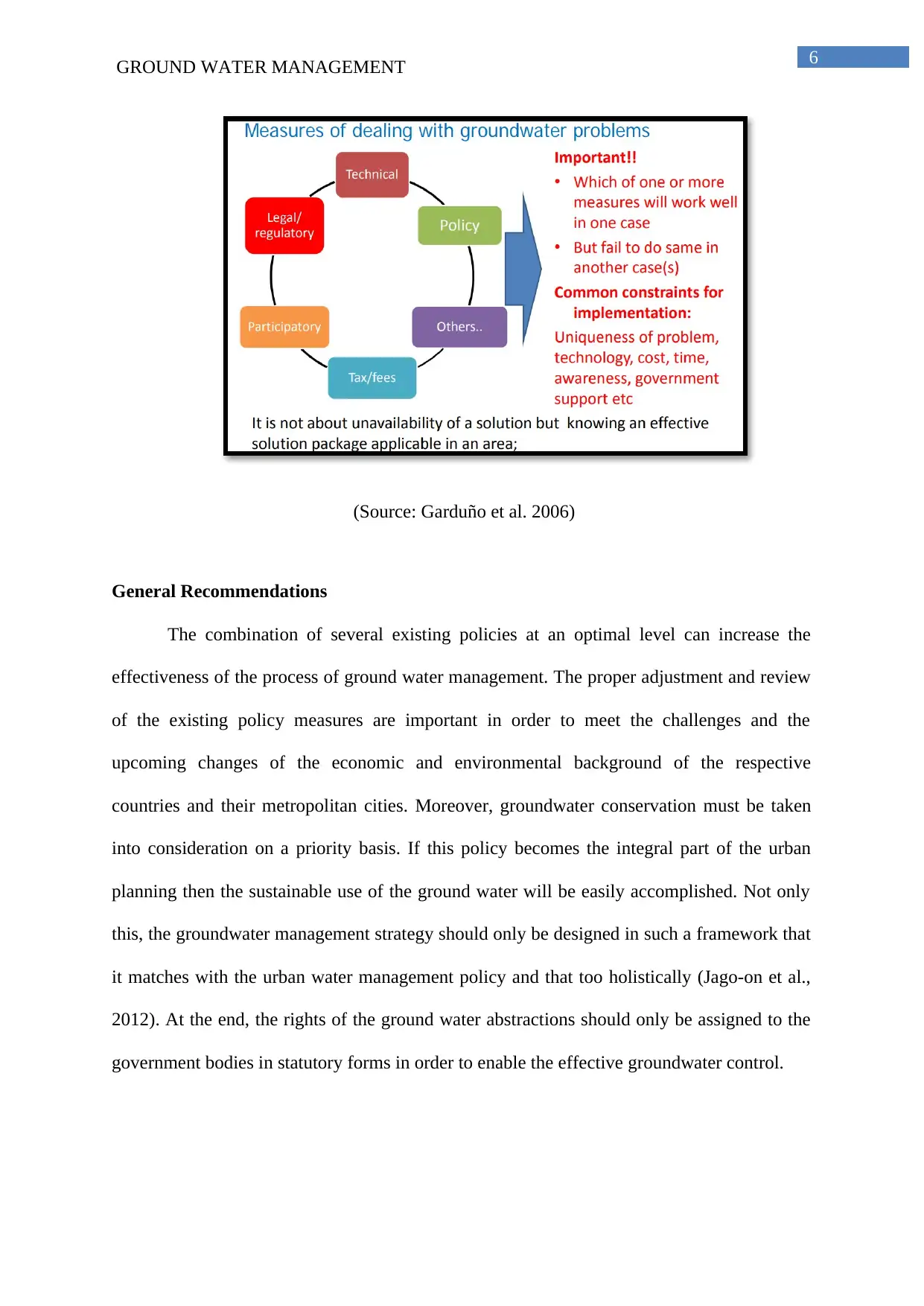
6
GROUND WATER MANAGEMENT
(Source: Garduño et al. 2006)
General Recommendations
The combination of several existing policies at an optimal level can increase the
effectiveness of the process of ground water management. The proper adjustment and review
of the existing policy measures are important in order to meet the challenges and the
upcoming changes of the economic and environmental background of the respective
countries and their metropolitan cities. Moreover, groundwater conservation must be taken
into consideration on a priority basis. If this policy becomes the integral part of the urban
planning then the sustainable use of the ground water will be easily accomplished. Not only
this, the groundwater management strategy should only be designed in such a framework that
it matches with the urban water management policy and that too holistically (Jago-on et al.,
2012). At the end, the rights of the ground water abstractions should only be assigned to the
government bodies in statutory forms in order to enable the effective groundwater control.
GROUND WATER MANAGEMENT
(Source: Garduño et al. 2006)
General Recommendations
The combination of several existing policies at an optimal level can increase the
effectiveness of the process of ground water management. The proper adjustment and review
of the existing policy measures are important in order to meet the challenges and the
upcoming changes of the economic and environmental background of the respective
countries and their metropolitan cities. Moreover, groundwater conservation must be taken
into consideration on a priority basis. If this policy becomes the integral part of the urban
planning then the sustainable use of the ground water will be easily accomplished. Not only
this, the groundwater management strategy should only be designed in such a framework that
it matches with the urban water management policy and that too holistically (Jago-on et al.,
2012). At the end, the rights of the ground water abstractions should only be assigned to the
government bodies in statutory forms in order to enable the effective groundwater control.
Paraphrase This Document
Need a fresh take? Get an instant paraphrase of this document with our AI Paraphraser
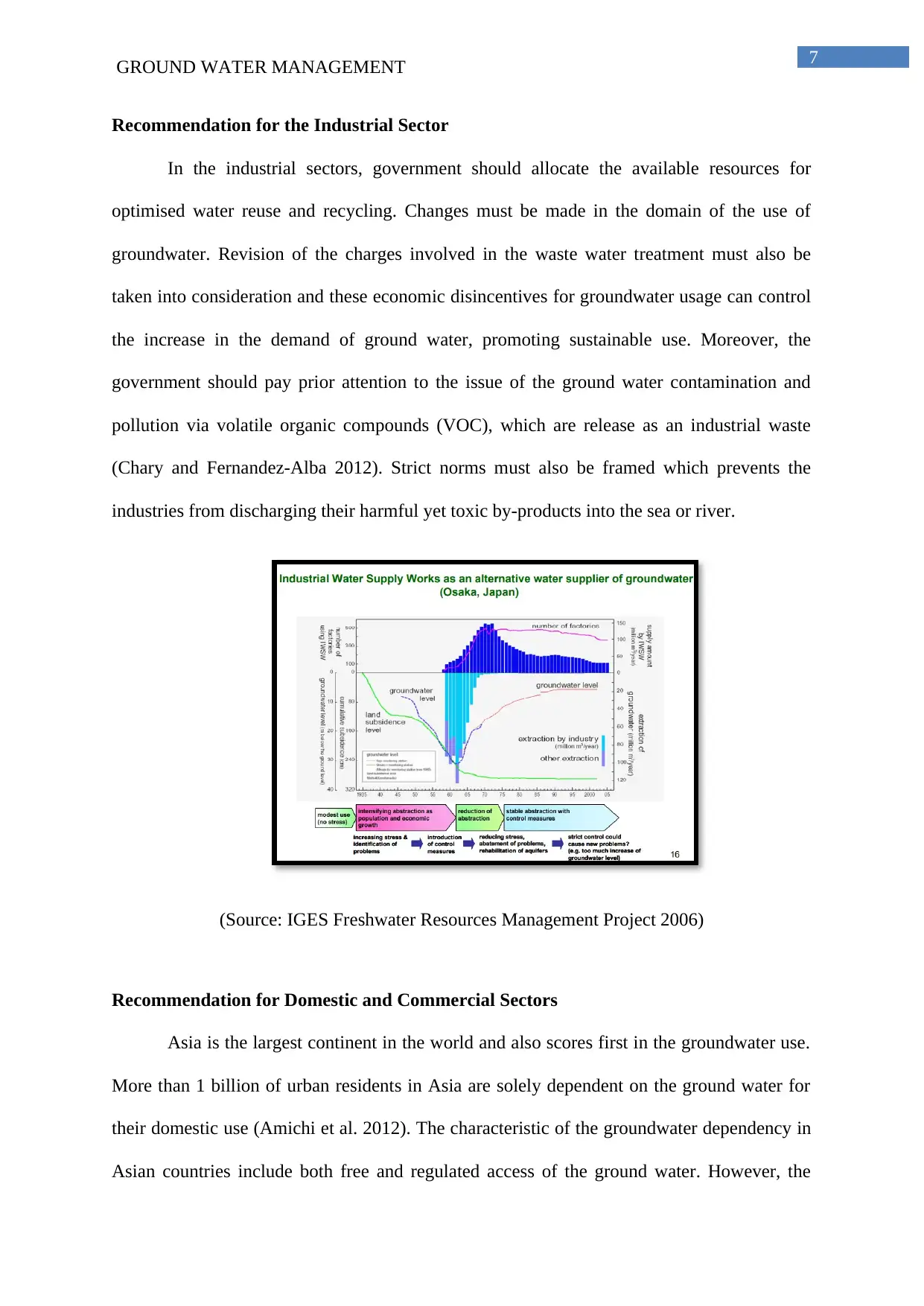
7
GROUND WATER MANAGEMENT
Recommendation for the Industrial Sector
In the industrial sectors, government should allocate the available resources for
optimised water reuse and recycling. Changes must be made in the domain of the use of
groundwater. Revision of the charges involved in the waste water treatment must also be
taken into consideration and these economic disincentives for groundwater usage can control
the increase in the demand of ground water, promoting sustainable use. Moreover, the
government should pay prior attention to the issue of the ground water contamination and
pollution via volatile organic compounds (VOC), which are release as an industrial waste
(Chary and Fernandez-Alba 2012). Strict norms must also be framed which prevents the
industries from discharging their harmful yet toxic by-products into the sea or river.
(Source: IGES Freshwater Resources Management Project 2006)
Recommendation for Domestic and Commercial Sectors
Asia is the largest continent in the world and also scores first in the groundwater use.
More than 1 billion of urban residents in Asia are solely dependent on the ground water for
their domestic use (Amichi et al. 2012). The characteristic of the groundwater dependency in
Asian countries include both free and regulated access of the ground water. However, the
GROUND WATER MANAGEMENT
Recommendation for the Industrial Sector
In the industrial sectors, government should allocate the available resources for
optimised water reuse and recycling. Changes must be made in the domain of the use of
groundwater. Revision of the charges involved in the waste water treatment must also be
taken into consideration and these economic disincentives for groundwater usage can control
the increase in the demand of ground water, promoting sustainable use. Moreover, the
government should pay prior attention to the issue of the ground water contamination and
pollution via volatile organic compounds (VOC), which are release as an industrial waste
(Chary and Fernandez-Alba 2012). Strict norms must also be framed which prevents the
industries from discharging their harmful yet toxic by-products into the sea or river.
(Source: IGES Freshwater Resources Management Project 2006)
Recommendation for Domestic and Commercial Sectors
Asia is the largest continent in the world and also scores first in the groundwater use.
More than 1 billion of urban residents in Asia are solely dependent on the ground water for
their domestic use (Amichi et al. 2012). The characteristic of the groundwater dependency in
Asian countries include both free and regulated access of the ground water. However, the
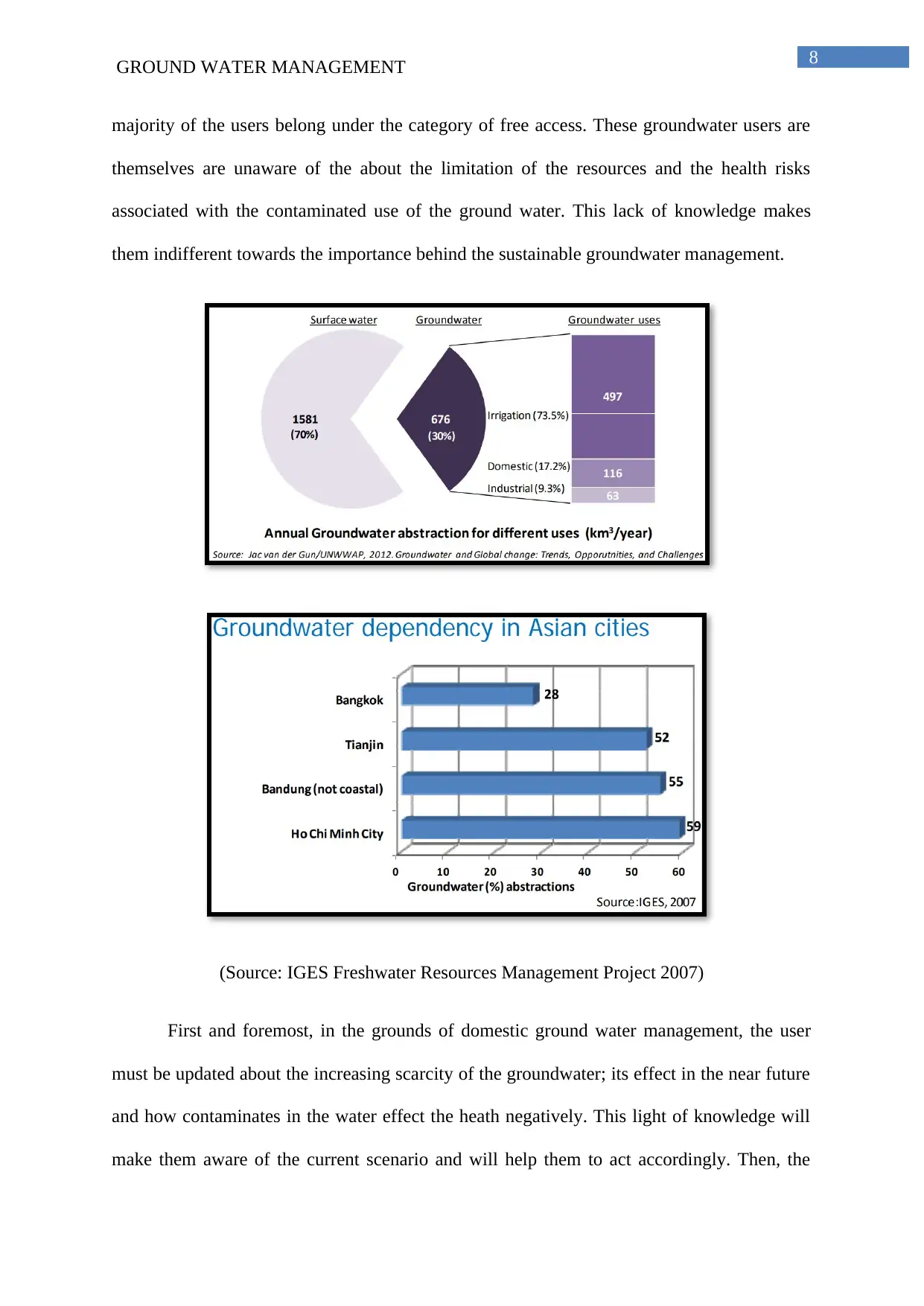
8
GROUND WATER MANAGEMENT
majority of the users belong under the category of free access. These groundwater users are
themselves are unaware of the about the limitation of the resources and the health risks
associated with the contaminated use of the ground water. This lack of knowledge makes
them indifferent towards the importance behind the sustainable groundwater management.
(Source: IGES Freshwater Resources Management Project 2007)
First and foremost, in the grounds of domestic ground water management, the user
must be updated about the increasing scarcity of the groundwater; its effect in the near future
and how contaminates in the water effect the heath negatively. This light of knowledge will
make them aware of the current scenario and will help them to act accordingly. Then, the
GROUND WATER MANAGEMENT
majority of the users belong under the category of free access. These groundwater users are
themselves are unaware of the about the limitation of the resources and the health risks
associated with the contaminated use of the ground water. This lack of knowledge makes
them indifferent towards the importance behind the sustainable groundwater management.
(Source: IGES Freshwater Resources Management Project 2007)
First and foremost, in the grounds of domestic ground water management, the user
must be updated about the increasing scarcity of the groundwater; its effect in the near future
and how contaminates in the water effect the heath negatively. This light of knowledge will
make them aware of the current scenario and will help them to act accordingly. Then, the
⊘ This is a preview!⊘
Do you want full access?
Subscribe today to unlock all pages.

Trusted by 1+ million students worldwide
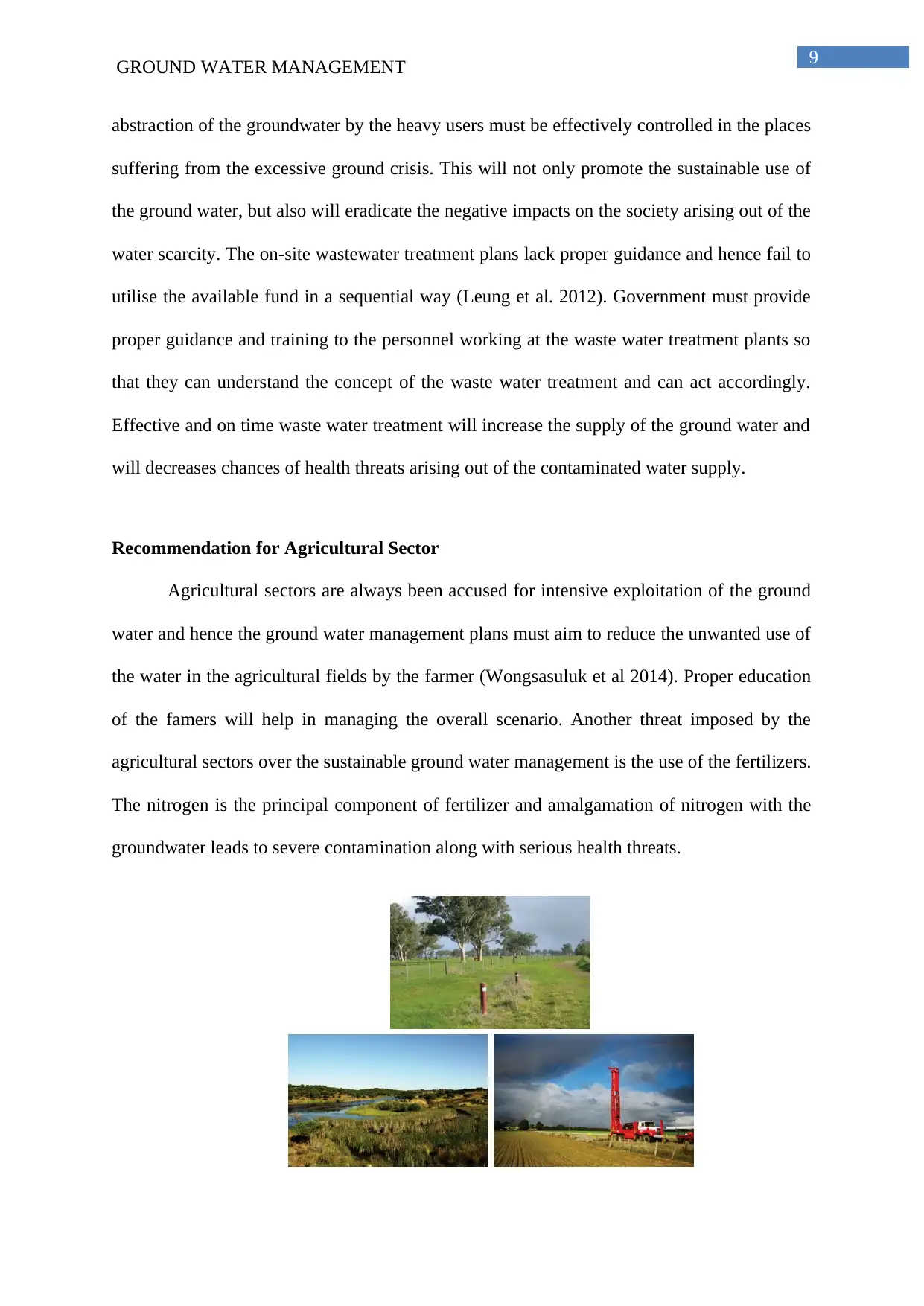
9
GROUND WATER MANAGEMENT
abstraction of the groundwater by the heavy users must be effectively controlled in the places
suffering from the excessive ground crisis. This will not only promote the sustainable use of
the ground water, but also will eradicate the negative impacts on the society arising out of the
water scarcity. The on-site wastewater treatment plans lack proper guidance and hence fail to
utilise the available fund in a sequential way (Leung et al. 2012). Government must provide
proper guidance and training to the personnel working at the waste water treatment plants so
that they can understand the concept of the waste water treatment and can act accordingly.
Effective and on time waste water treatment will increase the supply of the ground water and
will decreases chances of health threats arising out of the contaminated water supply.
Recommendation for Agricultural Sector
Agricultural sectors are always been accused for intensive exploitation of the ground
water and hence the ground water management plans must aim to reduce the unwanted use of
the water in the agricultural fields by the farmer (Wongsasuluk et al 2014). Proper education
of the famers will help in managing the overall scenario. Another threat imposed by the
agricultural sectors over the sustainable ground water management is the use of the fertilizers.
The nitrogen is the principal component of fertilizer and amalgamation of nitrogen with the
groundwater leads to severe contamination along with serious health threats.
GROUND WATER MANAGEMENT
abstraction of the groundwater by the heavy users must be effectively controlled in the places
suffering from the excessive ground crisis. This will not only promote the sustainable use of
the ground water, but also will eradicate the negative impacts on the society arising out of the
water scarcity. The on-site wastewater treatment plans lack proper guidance and hence fail to
utilise the available fund in a sequential way (Leung et al. 2012). Government must provide
proper guidance and training to the personnel working at the waste water treatment plants so
that they can understand the concept of the waste water treatment and can act accordingly.
Effective and on time waste water treatment will increase the supply of the ground water and
will decreases chances of health threats arising out of the contaminated water supply.
Recommendation for Agricultural Sector
Agricultural sectors are always been accused for intensive exploitation of the ground
water and hence the ground water management plans must aim to reduce the unwanted use of
the water in the agricultural fields by the farmer (Wongsasuluk et al 2014). Proper education
of the famers will help in managing the overall scenario. Another threat imposed by the
agricultural sectors over the sustainable ground water management is the use of the fertilizers.
The nitrogen is the principal component of fertilizer and amalgamation of nitrogen with the
groundwater leads to severe contamination along with serious health threats.
Paraphrase This Document
Need a fresh take? Get an instant paraphrase of this document with our AI Paraphraser
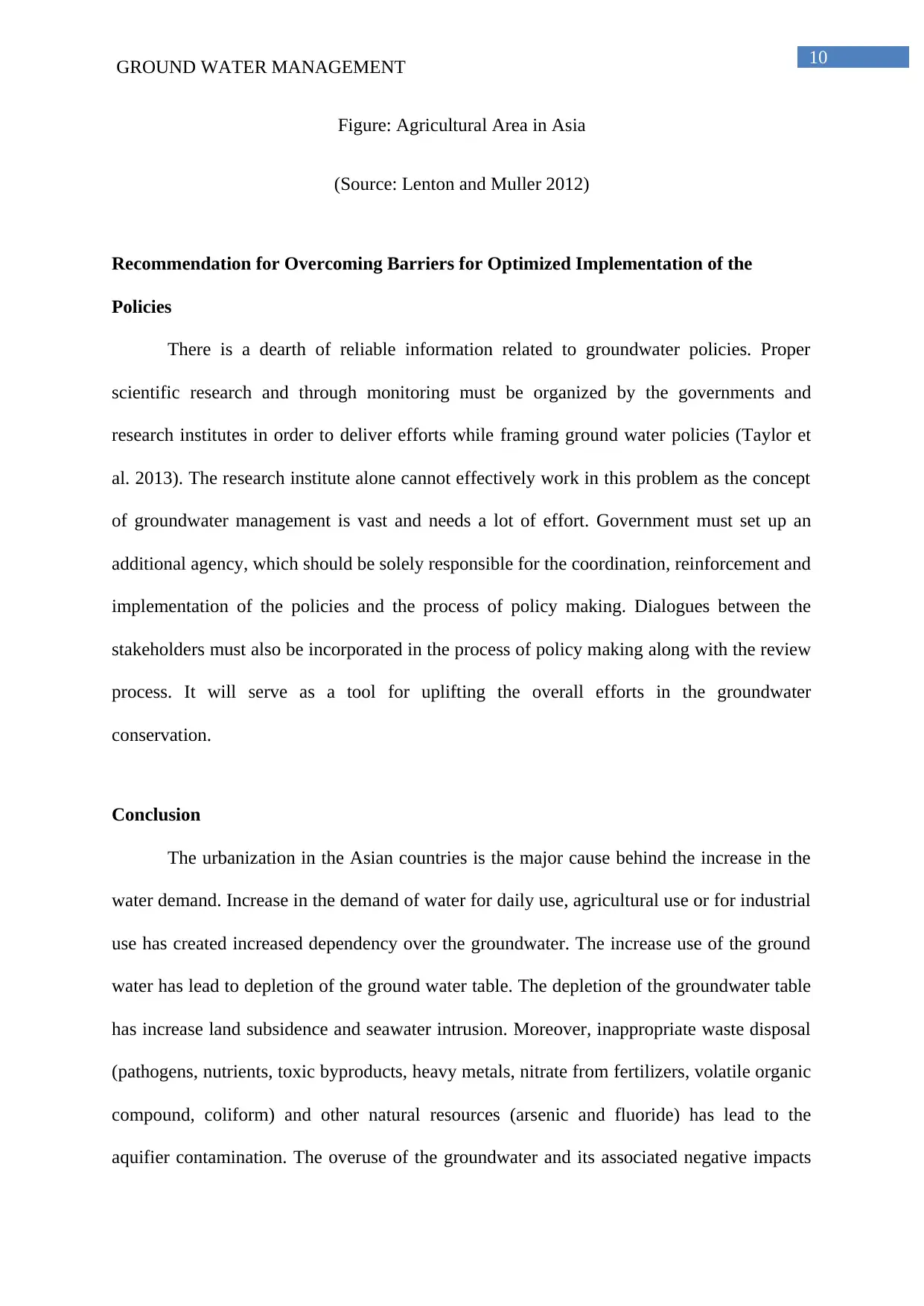
10
GROUND WATER MANAGEMENT
Figure: Agricultural Area in Asia
(Source: Lenton and Muller 2012)
Recommendation for Overcoming Barriers for Optimized Implementation of the
Policies
There is a dearth of reliable information related to groundwater policies. Proper
scientific research and through monitoring must be organized by the governments and
research institutes in order to deliver efforts while framing ground water policies (Taylor et
al. 2013). The research institute alone cannot effectively work in this problem as the concept
of groundwater management is vast and needs a lot of effort. Government must set up an
additional agency, which should be solely responsible for the coordination, reinforcement and
implementation of the policies and the process of policy making. Dialogues between the
stakeholders must also be incorporated in the process of policy making along with the review
process. It will serve as a tool for uplifting the overall efforts in the groundwater
conservation.
Conclusion
The urbanization in the Asian countries is the major cause behind the increase in the
water demand. Increase in the demand of water for daily use, agricultural use or for industrial
use has created increased dependency over the groundwater. The increase use of the ground
water has lead to depletion of the ground water table. The depletion of the groundwater table
has increase land subsidence and seawater intrusion. Moreover, inappropriate waste disposal
(pathogens, nutrients, toxic byproducts, heavy metals, nitrate from fertilizers, volatile organic
compound, coliform) and other natural resources (arsenic and fluoride) has lead to the
aquifier contamination. The overuse of the groundwater and its associated negative impacts
GROUND WATER MANAGEMENT
Figure: Agricultural Area in Asia
(Source: Lenton and Muller 2012)
Recommendation for Overcoming Barriers for Optimized Implementation of the
Policies
There is a dearth of reliable information related to groundwater policies. Proper
scientific research and through monitoring must be organized by the governments and
research institutes in order to deliver efforts while framing ground water policies (Taylor et
al. 2013). The research institute alone cannot effectively work in this problem as the concept
of groundwater management is vast and needs a lot of effort. Government must set up an
additional agency, which should be solely responsible for the coordination, reinforcement and
implementation of the policies and the process of policy making. Dialogues between the
stakeholders must also be incorporated in the process of policy making along with the review
process. It will serve as a tool for uplifting the overall efforts in the groundwater
conservation.
Conclusion
The urbanization in the Asian countries is the major cause behind the increase in the
water demand. Increase in the demand of water for daily use, agricultural use or for industrial
use has created increased dependency over the groundwater. The increase use of the ground
water has lead to depletion of the ground water table. The depletion of the groundwater table
has increase land subsidence and seawater intrusion. Moreover, inappropriate waste disposal
(pathogens, nutrients, toxic byproducts, heavy metals, nitrate from fertilizers, volatile organic
compound, coliform) and other natural resources (arsenic and fluoride) has lead to the
aquifier contamination. The overuse of the groundwater and its associated negative impacts
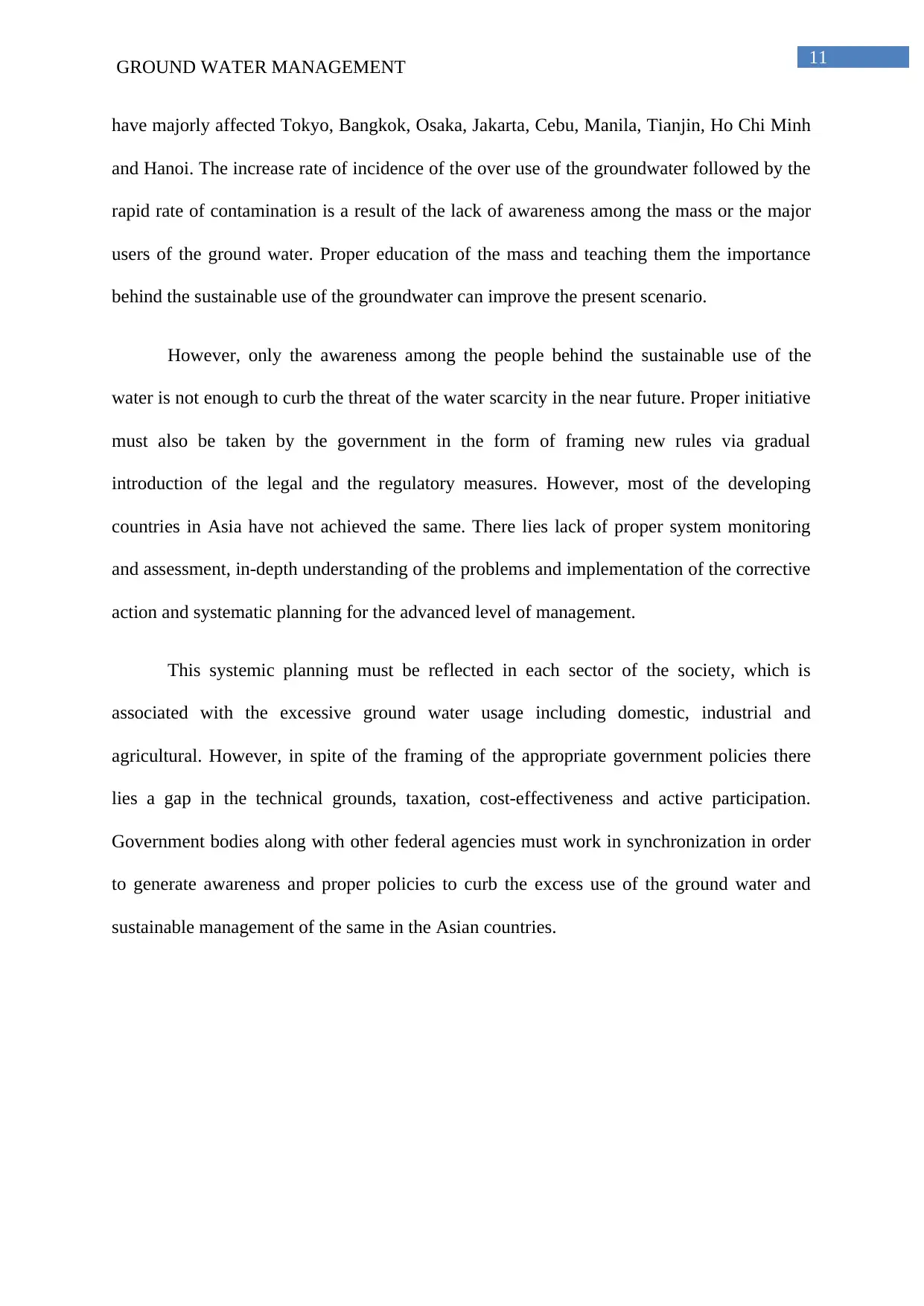
11
GROUND WATER MANAGEMENT
have majorly affected Tokyo, Bangkok, Osaka, Jakarta, Cebu, Manila, Tianjin, Ho Chi Minh
and Hanoi. The increase rate of incidence of the over use of the groundwater followed by the
rapid rate of contamination is a result of the lack of awareness among the mass or the major
users of the ground water. Proper education of the mass and teaching them the importance
behind the sustainable use of the groundwater can improve the present scenario.
However, only the awareness among the people behind the sustainable use of the
water is not enough to curb the threat of the water scarcity in the near future. Proper initiative
must also be taken by the government in the form of framing new rules via gradual
introduction of the legal and the regulatory measures. However, most of the developing
countries in Asia have not achieved the same. There lies lack of proper system monitoring
and assessment, in-depth understanding of the problems and implementation of the corrective
action and systematic planning for the advanced level of management.
This systemic planning must be reflected in each sector of the society, which is
associated with the excessive ground water usage including domestic, industrial and
agricultural. However, in spite of the framing of the appropriate government policies there
lies a gap in the technical grounds, taxation, cost-effectiveness and active participation.
Government bodies along with other federal agencies must work in synchronization in order
to generate awareness and proper policies to curb the excess use of the ground water and
sustainable management of the same in the Asian countries.
GROUND WATER MANAGEMENT
have majorly affected Tokyo, Bangkok, Osaka, Jakarta, Cebu, Manila, Tianjin, Ho Chi Minh
and Hanoi. The increase rate of incidence of the over use of the groundwater followed by the
rapid rate of contamination is a result of the lack of awareness among the mass or the major
users of the ground water. Proper education of the mass and teaching them the importance
behind the sustainable use of the groundwater can improve the present scenario.
However, only the awareness among the people behind the sustainable use of the
water is not enough to curb the threat of the water scarcity in the near future. Proper initiative
must also be taken by the government in the form of framing new rules via gradual
introduction of the legal and the regulatory measures. However, most of the developing
countries in Asia have not achieved the same. There lies lack of proper system monitoring
and assessment, in-depth understanding of the problems and implementation of the corrective
action and systematic planning for the advanced level of management.
This systemic planning must be reflected in each sector of the society, which is
associated with the excessive ground water usage including domestic, industrial and
agricultural. However, in spite of the framing of the appropriate government policies there
lies a gap in the technical grounds, taxation, cost-effectiveness and active participation.
Government bodies along with other federal agencies must work in synchronization in order
to generate awareness and proper policies to curb the excess use of the ground water and
sustainable management of the same in the Asian countries.
⊘ This is a preview!⊘
Do you want full access?
Subscribe today to unlock all pages.

Trusted by 1+ million students worldwide
1 out of 15
Related Documents
Your All-in-One AI-Powered Toolkit for Academic Success.
+13062052269
info@desklib.com
Available 24*7 on WhatsApp / Email
![[object Object]](/_next/static/media/star-bottom.7253800d.svg)
Unlock your academic potential
Copyright © 2020–2025 A2Z Services. All Rights Reserved. Developed and managed by ZUCOL.





